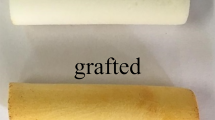Summary
Although conventional imprinting involving the use of charged functional monomers has been used by many authors for selective adsorption of small molecules, it has not been very successful with high-molecular-weight substances, for example proteins (“...macromolecules, such as proteins are difficult to apply as templates...”; H. S. Andersson, Doctoral Thesis, Trycki Högskolan Kalmar, 1999, p. 8.). Four years ago we therefore introduced an alternative method based on the polymerization ofnon-charged monomers (acrylamide andN,N′-methylenebisacrylamide) in the presence of the protein of interest. The selectivity of the gels for proteins was high (for instance, myoglobin from horse was adsorbed by a column designed to be selective for this protein, whereas, myoglobin from whale was not adsorbed) and they can therefore be regarded as ‘artificial antibodies’ (or ‘artificial receptors’).
This paper deals with improvements of the chromatographic properties of these gels. For example, by modifying the polymerization conditions the protein (hemoglobin) capacity, as well as the flow rate were increased fouifold. This was achieved by entrapment of the selective soft polyacrylamide gel in the pores of a rigid inert gel by letting the monomers and the protein diffuse into the pores of agarose beads (SepharoseTM) before starting the polymerization. The gel formed was cut into pieces. The agarose beads were freed from the surrounding polyacrylamide gel by stirring. This technique is universal and is recommended also for molecular imprinting studies of small molecules.
Another universal method has been introduced for rapid screening of potential monomers and gels for the preparation of selective adsorbents. This very simple method is based on the assumption that the absorption maximum of a protein changes when the protein interacts with the free monomers or the adsorbent synthesized from the monomers (and does not change when the protein does not interact). Preliminary docking experiments indicate that selective adsorption of the protein by the polyacrylamide matrix is based primarily on hydrogen-bonding and dipole-dipole interactions. The strengths of these interactions can be varied by choosing different gel matrices (for removal of a given protein the interactions should be very strong, whereas they should be weaker for chromatographic analysis).
Similar content being viewed by others
References
Wulff, G.; Sarhan, A.,Angew. Chem. Int. Ed. Engl. 1972,11, 341.
Wulff, G.; Oberkobusch, D.; Minárik M.Reactive Polymers 1985,3, 261.
Wulff, G.; Minárik, M. InChromatographic Chiral Separations: Zief, M.; Crane, L. J., Eds, Marcel Dekker, New York,1988, p. 15.
Wulff, G.; Minárik, M.J. Liq. Chromatogr. 1990,13 (15), 2987–3000.
Vlatakis, G.; Andersson, L. I.; Müller, R.; Mosbach, K.Nature 1993,361, 645–647.
Sellergren, B.; Shea, K. J.J. Chromatogr. A 1993,654, 17–28.
Nicholls, I.A.; Ramström, O.; Mosbach, K.J. Chromatogr. A 1995,691, 349–353.
Jones, C.; Patel, A.; Griffin, S.; Martin, J.; Young, P.; O'Donnell, K.; Silverman, C.; Porter, T.; Chaiken, I.J. Chromatogr. A 1995,707, 3–22.
Plunkett, S.D.; Arnold, F.H.J. Chromatogr. A 1995,708, 19–29.
Mosbach, K.; Ramström, O.Bio/Technology 1996,14, 163–170.
Hosoya, K.; Yoshizako, K.; Shirasu, Y.; Kimata, K.; Araki, T; Tanaka, N; Haginaka, J.J. Chromatogr. A 1996,728, 139–147.
Dauwe, C.; Sellergren, B.J. Chromatogr. A 1996,753, 191–200.
Schweitz, L.; Andersson, L.I.; Nilsson, S.Anal. Chem. 1997,69, 1179–1183.
Walshe, M.; Garcia, E.; Howarth, J.; Smythe, M.R.; Kelly, M.T.Anal. Commun. 1997,34, 119–121.
Brüggemann, O.; Freitag, R.; Whitcombe, M.J.; Vulfson, E.N.J. Chromatogr. A 1997,781, 43–53.
Schweitz, L.; Andersson, L.I.; Nilsson, S.J. Chromatogr. A 1997,792, 401–409.
Lin, J. -M.; Nakagama, T.; Uchiyama, K.; Hobo, T.J. Liq. Chromatogr. Rel. Technol. 1997,20, 1489–1506.
Tan, Z.J.; Remcho, V.T.Electrophoresis 1998,19, 2055–2060.
Schweitz, L.; Andersson, L.I.; Nilsson, S.J. Chromatogr. A 1998,817, 5–13.
Hosoya, K.; Yoshizako, K.; Sasaki, H.; Kimata, K.; Tanaka, N.J. Chromatogr. A 1998,828, 91–94.
Andersson, H.S.; Karlsson, J.G.; Piletsky, S.A.; Koch-Schmidt, A.; Mosbach, K.; Nicholls, I.A.J. Chromatogr. A 1999,848, 39–49.
Joshi, V.P.; Kulkarni, M.G.; Mashelkar, R.A.J. Chromatogr. A 1999,849, 319–330.
Haginaka, J.; Takehira, H.; Hosoya, K.; Tanaka, N.J. Chromatogr. A 1999,849, 331–339.
Liao, J. -L.; Wang, Y.; Hjertén, S.Chromatographia 1996,42, 259–262.
Hjertén, S.; Liao, J. -L.; Nakazato, K.; Wang, Y.; Zamaratskaia, G.; Zhang H. -X.Chromatographia 1997,44, 227–234.
Andersson, H.S.Towards the Rational Design of Molecularly Imprinted Polymers, Doctoral Thesis, Tryck i Högskolan, Kalmar,1999.
Sybyl 6. 6 Tripos Inc., 1699 South Hanley Rd., St. Louis, Missouri, 63144, USA.
Morris, G.M.; Goodsell, D.S.; Halliday, R.S.; Huey, R.; Hart, W.E.; Belew, R.K.; Olson, A.J.J. Comput. Chem. 1998,19, 1639–1662.
Hjertén, S.Arch. Biochem. Biophys.,1962,Suppl 1, 276–282.
Hjertén, S.Trends Anal. Chem. 1984,3, 87–90.
Author information
Authors and Affiliations
Rights and permissions
About this article
Cite this article
Tong, D., Heényi, C., Bikádi, Z. et al. Some studies of the chromatographic properties of gels (‘Artificial antibodies/receptors’) for selective adsorption of proteins. Chromatographia 54, 7–14 (2001). https://doi.org/10.1007/BF02491825
Received:
Revised:
Accepted:
Issue Date:
DOI: https://doi.org/10.1007/BF02491825




